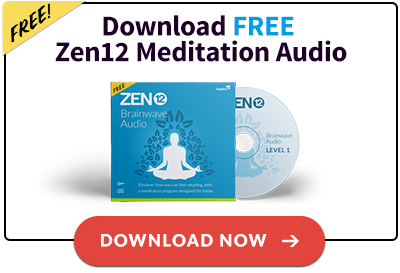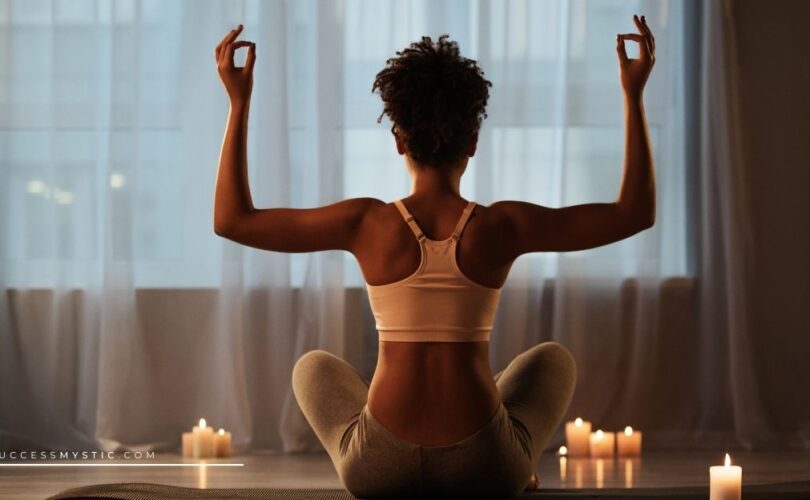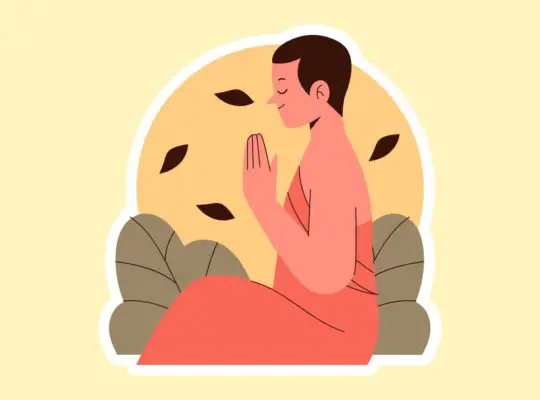In This Article: How to reap the enormous benefits of a centuries old tradition practiced by millions in modern times.
Have you ever really taken the time to consider what meditation is? Maybe you have tried to meditate at one time or another, but were never truly successful. Why?
Is it because you do not know what to do? Not likely, because you can find hashed around definitions of what it is, all over the place. In fact, most practitioners of meditative exercise will tell you to “empty your mind,” but in practice, this is much easier said than done.
Instead, meditation should be regarded as a state when the mind is not worrying about the past or future, but rather in “thoughtless awareness.”
For example, to focus on nothing else besides your breathing can be considered meditation. Similarly, sitting next to a waterfall and being aware of nothing except the sound of the waterfall is also meditation.
To put meditation into perspective, it is the state of being aware of a single thought. A man working in the field extremely focused on doing repetitive work is in theory in a deeper meditative state than someone sitting in a serene peaceful area with random thoughts fluttering through their mind.
Why Make Meditation A Part of Your Healthy Lifestyle
The benefits of meditation are wide and far-reaching and can help improve your quality of life, and the state of your mind, body, and spirit. Below are just some of the proven benefits of meditation.
1| Boost Concentration
The tenets of effective meditation have to do with the ability to block distractions and sharpen mental acuity. Enhanced concentration means you are better able to focus on a singular task, or even multitask with few well-defined objectives at the same time. In turn, this enhanced concentration translates to longer-term memory as well, as deeper connections are made in the neurons found in the brain.
2| Increase Self-Awareness
Most people think that they have a handle on what it means to be self-aware, but in reality, most people do not. Being self- aware refers to being able to recognize traits of your individuality, whether it is good or bad. For example, you can manifest as a classic “angry” individual, but to yourself, nothing is wrong.
Being self-aware means that you are able to pinpoint when your angry responses are occurring, with the objective of correcting and bettering yourself. When you take the time to meditate, you become better acquainted with yourself, ultimately becoming more comfortable with who you are, along with acquiring a much deeper understanding of self.
3| Improve Heart and Immune System Health
Although it is not fully understood why meditation improves health of these systems, it is thought to be related to the effect that relaxation has on the beneficial compound Nitric Oxide. Nitric oxide helps to relax blood vessels, lowering blood pressure, and could help in the expression of white blood cells, which are immune boosting cells.
4| Bust Stress
One of the primary reasons people try to meditate in the first place is to escape a world filled with stress. In addition, of course, meditation is highly efficacious in achieving stress reduction. Effectively performed, persons are able to gain control over both their nervous and emotional wellbeing, reducing the need to prescription medications to treat or help manage the same.
The calmness and quite brought to the mind during a meditative session does not end with the session. Actually, it transfers to day to day life, and becomes a sort of coping skill, so the practitioner is able to better handle stress and stressful events with a heightened level of acceptance so those stressors have much less of an effect on his or her mind and body.
5| Slow The Aging Process
Of particular interest is the massive benefits meditation can have on the aging process. Studies have shown that meditation alters brain chemistry to slow aging, and that people who meditate tend to have higher densities of gray matter in the brain (basically, more brain cells) helping to stave off dementia and age related cognitive decline.
Finally, people that meditate have been found to have longer Telomeres, the cap ends of chromosomes, which as they become frayed over time, speed up aging. This translates to a reduced biological age, even though you cannot alter chronological age (basically looking like 30 when you are 60).
What The Studies Show: Meditation And Aging
Let’s face it, a statement is not worth anything without definitive proof, and that is what these scientific studies provide.
1| The Telomeres Study
If there was one study that revolutionized the role meditation has on slowing aging, it was the one initiated in the year 2000, by two physicians specializing in disciplines light years apart- or so it was thought up to that time. The two physicians, Dr. Elizabeth Blackburn, was a biochemistry specialist, and Dr. Elissa Epel from UCSF’s psychiatry department broke new ground when they were able to prove that stress from daily lives could accelerate biological aging by decades in a matter of years.
They were more specifically monitoring the length of telomeres, the “end cap” of chromosomes, which naturally become worn down following years of cellular replication, and the enzyme telomerase, which helps to protect and even rebuild telomeres.
After about 4 years, the researchers were able to gather 58 suitable subjects- all mothers of ill children, which classically are subject to higher levels of stress than the average population.
After the blood was analyzed from the subjects, the monumental results were reported- the more stress the subject was exposed to, the resulting lower their telomere length, and levels of telomerase enzyme.
This was the first solid proof that stress doesn’t just have negative health consequences- but literally ages you as well.
In addition, studies carried out specifically on the use of meditation, including transcendental meditation, reduced the death rate in the following 3 years to virtually 0%, as all the subjects survived for that period of time, compared to control groups.
Furthermore, the improvements gained from meditation were far beyond physical, as subjects also were able to maintain cognitive function and intelligence for a longer period of time.
2| Increased Cortical Thickness
Putting aside all the mumbo-jumbo, the cortex is an area in the brain that is responsible for planning and attention, which naturally thins as we grow older.
However, a study conducted in 2005 showed that meditation practitioners had remarkably thicker frontal cortex areas of the brain, resulting in more years at optimal cognitive efficiency. The results were most pronounced in elderly practitioners, suggesting that it may help offset age related changes to the brain.
3| Improved Blood Flow In The Brain
As if these proven effects of meditation on physical aging are not enough, meditation does help to maintain functionality of an elderly brain.
Since many conditions of aging are associated with diminished blood flow to the brain, it is interesting to note a study performed in 2009 that demonstrated significant changes to cerebral blood flow following sessions of chanting meditation, via CT scans.
4| Increase In Gray Matter
Do you know how important the brain’s gray matter is? Simply put, it is what keeps your brain responding to the characteristics that make you, you.
The functions of gray matter are diverse, but most importantly include maintaining healthy skeletal muscle strength and functionality, keeping you sensitive to fine touch, and spatial awareness.
Meditation again has been shown to reduce the age associated loss of this important brain tissue, keeping you functioning well into your golden years, in some cases even reversing the loss and improving density altogether.
In 2015, a study published in the Frontiers in Psychology journal described research conducted at UCLA, which is an extension on their earlier work that suggested that meditation results in a decrease in age-related atrophy in the brain’s white matter. The current study now shows that meditation appears to help preserve the brain’s gray matter as well.
The study looked at age and gray matter decline and compared 50 people who had mediated for years with 50 who had not. Both groups of people showed the expected loss of age related gray matter, but the decline was much less in those who meditated versus those who did not.
One of the co-authors, Dr. Florian Kurth, a doctoral fellow at the UCLA Brain Mapping Center reflected that the researchers were very surprised at the magnitude of the difference as they did expect some distinctions, but not the widespread effect they found that meditation had on regions all over the subject’s brains.
It seems that while in modern times a lot of attention is paid to identifying and decreasing risk factors for dementia and other forms of cognitive decline to counteract the overwhelming incidence of such in baby boomers and the elderly, it may be more beneficial to engage in activities that actually enhance brain health, such as mediation.
5| More Anti-Aging Benefits of Meditation
We all know that the first thing that comes to mind when thinking of anti-aging is looking younger, but did you know there are also a host of processes going on inside the body at the same time? Things that we scarcely consider to actually contribute to making us age, but are the primary driving factors being it.
Worried about that odd gray hair you spotted this morning? Sure tweezing is a quick fix, but that’s not to say another won’t appear in a few days!
However, in order to understand the mechanism behind how aging happens, let’s have a brief summary of the processes that occur:
Natural Growth Hormone Production Drops Significantly – from the time we turn 30 years or so, our natural production of growth hormone slows down significantly. Unless you’ve been under a rock for the past decade or so, you have probably heard about the benefits of growth hormone on aging, such as improving skin suppleness and keeping body fat levels in check. People have been using growth hormone skin injections in their quest to find everlasting youth, and with reasonable levels of success.
DHEA Production Is Decreased – DHEA is a critical natural sex hormone that is converted into either testosterone or estrogen, depending on the gender of the individual and particular needs at that time. DHEA plays an important role in maintaining a healthy sex drive, regulating energy levels, keeping the stress hormone cortisol in check and maintenance of a positive mood.
Shrinkage Of The Pineal Gland – shrinks gradually over time, until eventually it becomes calcified or a remnant of its former self, with it occurring diminished production of the important sleep hormone melatonin. Melatonin regulates sleep cycle and is a powerful anti-oxidant, possibly explaining the reduced resistance and higher incidence of insomnia that occur in older populations.
Reduced Capacity Of The Hypothalamus – the hypothalamus is one of the most important structures in the brain, acting as a sort of “supervisor” to other systems, most importantly the pituitary gland. As aging occurs, the hypothalamus is much less able to maintain balance over body processes, and fails to appropriately link the body’s nervous and endocrine systems.
In fact, without an optimally functioning hypothalamus, these key body processes quickly go out of whack:
- Blood Pressure
- Body Temperature Regulation
- Appetite and maintenance of body weight
- Fluid and electrolyte balance
- Digestive processes, including secretions of the stomach and intestines
- Release of key hormones from the pituitary gland
Suppression of The Immune System – suppression of the immune system normally occurs in conjunction with decreased hormone and endocrine output, resulting in ease of picking up infections, and overall reduced resistance to illness as you age.
As you can see, aging comes about as a result of all of these processes gradually over time, but not necessarily as a result of old age.
What does this mean?
It means that today, more and more young people are appearing with symptoms that mimic populations 10, or even 20 years older than them. Therefore, it is not at all uncommon to see a 30 year old suffer from a heart attack, when in the past only people 50 years and older typically experienced these health conditions.
Meditation has once again proved beneficial in alleviating these health and youth suckers from our body, at least relieving the rate at which age related degradation occurs.
How does meditation work to exert anti-aging effects?
- Reduces levels of the stress hormone cortisol
- Decreases the need for and subsequent use of powerful prescription anti-depressants among other drugs
- Lowers blood pressure by relaxing blood vessels
- Natural anti-anxiety treatment recommended by natural health practitioners
- Improves blood flow to the brain helping improve health neuronal impulses and pulsatile release of hormones
8 Types of Specific Meditative Techniques To Slow Aging
Here are eight meditation practices that are especially beneficial to slow aging process.
1| ZAZEN
When it comes to meditative form, Zazen is typically what we visualize. Zazen literally translates to “seated meditation” and is used widely throughout the world, originating in the east. Also known as Zen Meditation, it may be used as a means of enlightenment, or the nature of existence. If you’re completely new to the meditative arts, Zazen is likely to be the best fit for you, as its ease of implementation is second to none.
How To Perform Zazen
To begin with, it may be a good idea to get a small, soft pillow to sit on as you start the session. Though it is completely optional, to keep you from getting distracted because of a painful backside, it is better to use one.
1| Choose A Position – yes, not all Zazen is performed in the same-seated position. There are actually quite a few positions, which range in difficulty and comfort level, from easy to hard, listed in that order:
- Burmese Position- the simplest position to begin with, in which the legs are crossed, with both knees on the floor and one ankle in front of the other, as opposed to resting on each other.
- The Half Lotus Position (Hankafuza)- this is the second least technical position, which is just a “bend” away, literally. This position is identical to the Burmese, except that in this case, one ankle is placed on the thigh of the opposite leg, while the next ankle remains on the floor, preferably tucked under the thigh of the elevated ankle. This position should be implemented after a few sessions of the Burmese Position, since if you immediately begin with this you may experience cramping and muscle pain afterwards.
- The Full Lotus Position (Kekkafuza)- this is the most complex position, and likely painful for a new practitioner, but is also the most stable of them. Of all the Zazen positions, the Full Lotus is touted to have the most benefits on health, including alleviation of muscle tightness, and improving energy levels. However, caution should be taken in individuals with join issues, as it may be uncomfortable towards knee pain. If pain is pronounced after a session, apply warm water compress.
- Other Positions- these are not typical Zazen positions per se, but are still classified as such. They include the kneeling position, chair position (sitting in a chair), and the standing position.
2| Place Your Hands In The “Cosmic Mudra” Position – basically a position with one hand resting gently in the other, both palms facing towards the sky. Your dominant hand is placed on top, with thumbs slightly touching.
3| Try to clear your mind, focusing on nothing except your breath. You may close your eyes if it allows you to better clear your mind.
4| Begin counting the breaths you take, up to ten. Once you reach ten, start over from one again. If you are distracted by a wandering thought before you reach ten, that’s ok- just start over again. When you are able to successfully reach the count of ten multiple times, you have had a successful session.
Start Small – even just 5 minutes daily, and increase by 5 minutes each subsequent week. If you find counting too distracting, set a stopwatch away, which will let you know when you’ve done enough, because as you progress you need to focus solely on the breath, and no so much on keeping track of numbers
2| Transcendental Meditation
One of the most widely studied meditative techniques, Transcendental MeditationTM (TM) was brought to the limelight during the 1950’s by Maharishi Mahesh Yogi. It is a silent mantra based meditation, which involves the use of silently focusing on a repetitive phrase. TM is usually performed twice daily, for sessions of 20 minutes each, but does not require any particular meditative position (such as the Lotus, etc.).
The goal of TM is to leave the mind in an “open attentional stance,” which is to induce an effortless relaxation, and handling thoughts that may come to mind, but to process and let it transcend.
Many practitioners claim it helps them to experience a scenario similar to “lucid dreaming,” in which the mind is in a state of not wakefulness, neither asleep nor dreaming but rather detached from the physical body, so distractions are minimized. Currently, over 4 million people practice transcendental meditation.
3| Kundalini
In literal translation, Kundalini means coiled, as a snake would. It is better represented as an energy form, not recognized by western medicine, lying dormant at the base of the spine until it is appropriately “awakened” via intense meditative practice and breathing exercises.
Achieving Kundalini through meditation is considered extremely difficult, and should only be attempted by those dedicated to accelerate their spiritual journey towards transcendence. Awakening of Kundalini is experienced as an unexplained bliss or enlightenment, and is physically felt like a jolt of electricity travelling up the spine towards the head or as heat moving in the same direction.
There are multiple ways to actually awaken Kundalini, such as by transmission from a guru, or via intense yoga and meditation. Others have reportedly experienced Kundalini from intense emotional trauma, such as the death of a loved one or following recovery from a near death experience.
4| Qigong
One of the most widespread meditative arts, Qigong originated in the Orient and is now practiced worldwide. Translated to literally “the cultivation of life energy,” Qigong is believed to give humans access to higher realms of awareness, as well as developing the true nature and potential of a person. Interestingly, Qigong has roots in many applications, such as martial arts, Chinese medicine, and alternative healing.
For the purpose of this discussion, we will be looking at Qigong Meditation, which is practiced via the use of mantra chanting, breath visualization, with the ultimate goal of calming the mind. It is interesting to note that breath visualization is not the only focal target- you can choose literally anything, but which does not give way to many distractions (think of the horizon or a stream).
People who practice Meditative Qigong typically tend to focus on development of virtue and patience, with the ultimate end goal of enlightenment.
5| Guided Visualization
Guided Visualization, also known as guided imagery, involves the use of typically sounds, smells, and textures to elicit a particular response associated with peace and relaxation. It is well known that the body and mind are linked, and the brain can elicit changes on the body just by thinking of it (or via imagery).
Guided visualization can be especially useful for individuals who have a difficult time zoning in on relaxing stimuli, and is either performed in a class by a trained instructor, or in the comfort of your home using a pre- recorder audio session.
A good example of guided visualization would be to close your eyes, imagine the seaside – the sound of the waves, the texture of sand under your feet, and using an aromatic aid that brings thoughts of the seaside.
6| Deep Trance Meditation
Deep Trance Meditation is a highly sought after state that resembles when you are just about to fall asleep, when you are mentally awake but your body is asleep. The goal of deep trance meditation is to be able to “program” the subconscious right side of the brain, which can elicit greater creativity and ingenuity. While the left side of the brain is the “problem solving” logical side we use when awake, it does not normally function in unison with the right hemisphere. By practicing deep trance meditation, you are able to synchronize the two sides, forging deep neuronal connections and increasing mental capacity.
The first typical sign of entering the tranced state (also known as light trance) is the sensation of falling. Many of us have experienced this light trance state before as we begin to fall asleep, but it takes practice to translate that state into the longer full trance state.
7| Heart Rhythm Meditation
Heart rhythm meditation involves focusing consciously on the pulse rhythm of the heart, as a means of bringing about relaxation. For example, one breath may last 8 beats of the heart, while exhalation is equal to the same. Alternately, an inhale may last eight beats, followed by holding of the breath for 16 more beats, then finally exhalation for 8 more beats.
Such a technique is known as a “Squared Breath.” Heart Rhythm Meditation is extremely efficient in relieving anxiety or nervousness, and calming your heart rate and breathing patterns.
8| Mindfulness Meditation
Different from many other meditative styles, mindfulness emphasizes focusing on thoughts during the meditative session, which come up at that time. For example, thinking about the way you feel, or noticing the sounds and smells around you.
It is important to note that you should not focus too much or linger on thought at this time, as is the goal of mindfulness- to live in the present, and not be haunted by the regret of the past or fear of the future.
Getting Started With Meditation
All you have just learned would be futile if you don’t actually put into practice the techniques mentioned.
As such, here is a quick-start guide for you to start on your journey to wholesome physical, mental, and spiritual health:
- Start By Having A Seat – chances are you’re new to meditating so take note that a seated position is much less distracting than standing when you are distracted by leg pain and constant position fidgeting. Grab a cushion for comfort, and ensure your spine is upright.
- Relax Eye Tension – this means, gently close your eyes, but without squinting or hard closing them. If you find yourself forcefully having to close them, you can try focusing on a plain object in front of you- not too many details or you will get distracted.
- Let It Go – no, we are not singing the Frozen soundtrack from Disney, but rather referring to what you should do to thoughts that do not belong in your mind at that particular moment. No worrying about bills or your job. If you are having a hard time doing so, focus strictly on your breath.
- Be Consistent – meditation does not have to and should not be viewed as a task. The key is to start very easy – just 5 minutes a session and not penalizing yourself for mistakes or the inability to sit still. In fact, for most sitting still is a skill that is learned with much practice, and so is clearing the mind and focusing on the present. It is normal to have wavering thoughts at the beginning, but the key is to remove unnecessary ones as they originate, and focus on your breath to establish base. Then, strive to add 5 minutes every week until you reach 20 minutes per session, and practice every single day. It does not require lots of physical energy, so excuses should be absent as well!
- Live, Love Enjoy – as you progress, you will learn to enjoy every moment of life as it occurs, and not be distracted by things that get in the way. You may notice your relationships improve, stress levels lower and as you get older your brain will certainly show the rewards of your efforts.
What Next?
Meditation can often be pretty TOUGH.
Trying to quieten a chatty mind and restless body is hard work. Finding 45-60 minutes a day for real meditation is almost impossible. And waiting for results seems to take forever.
But we all *know* that we should be meditating more.
Well, there’s a solution…
Something that automatically calms your mind and body, and gives you a powerful one-hour meditation session — all in just 12 minutes.
The results are instant too. This technique dissolves stress and anxiety immediately. It stimulates focus, creativity, and more energy and happiness, while you listen.
Seriously — check this out:

I really think you’re gonna love this.
(PS. Keep this email safe. You can use the code VZ54YTD6 during checkout if you ever want to purchase the whole thing. That’ll give you $50 off, making the whole package just $47.)







